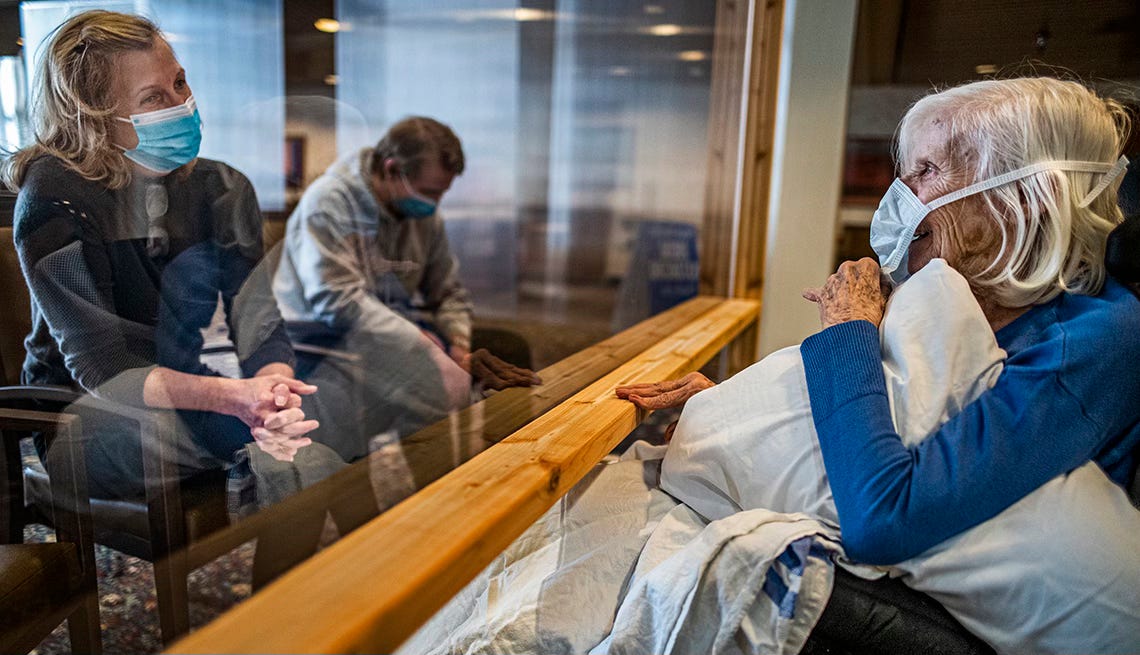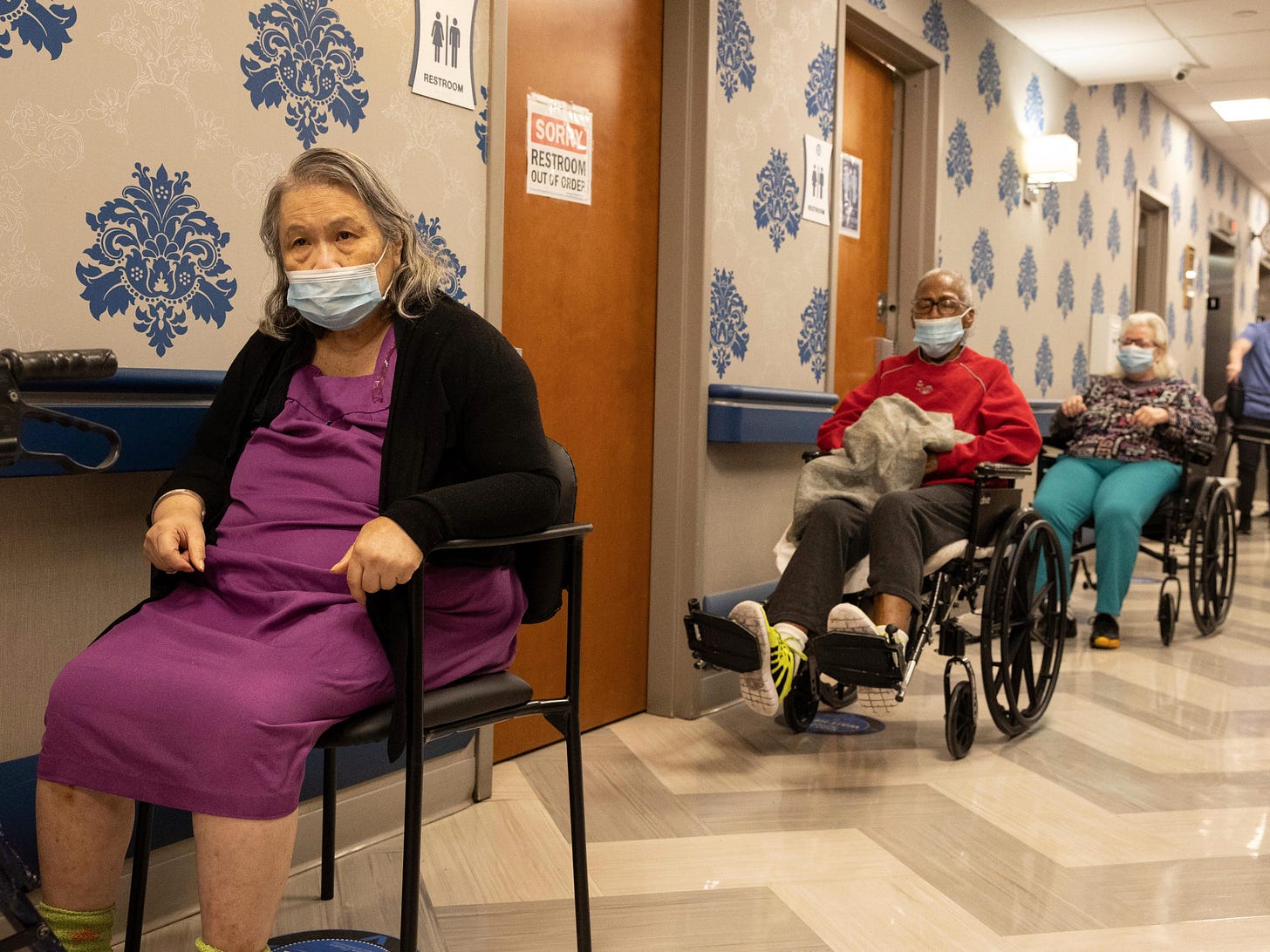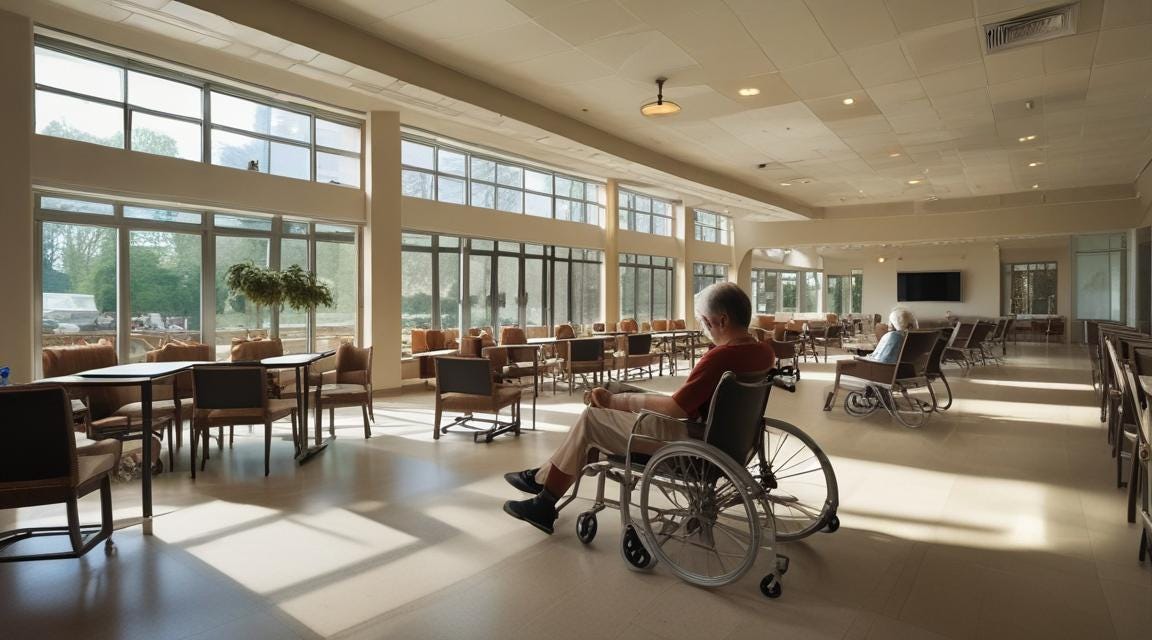Living from COVID to Later Die from Loneliness and Despair?
There’s no other way to look at it - I have watched this happen with my own eyes
Quick article based on some discussion I was seeing on X today - a longtime follower and friend (back when it was Twitter!) posted a link to the following article:
This generated a discussion and even invited some extensive commentary from Dr. Jay Bhattacharya, who at this point feels like an old friend:
I’ve written extensively about the effects of lockdown policies on US nursing home care as they started in early 2020, which by any measure were more extreme and frankly, medieval than anything ever seen in K-12 schools or general medical beds or hospital clinics, typified in my mind by the horrific psychological torture of “public health interventions” like:
“Window visits” - where residents, often with significant memory impairment along with sensory impairment (deafness, blindness) were forced to endure several weeks / months of isolation from their families and only were allowed the farce of interacting with family behind glass I wrote an earlier Substack article about this here.
Forced masking policies - still in effect to this day, although I would wager far less reliably enforced (because most of us all know, at least instinctively, they are for show), but still with deleterious effects on our most vulnerable residents with hearing and cognitive impairment. I also wrote about this here, noting the vicious, sociopathic ableism of masking policies - my most popular article to date.
The shutting down of nursing home communal dining - what I call the social and emotional “beating heart” of nursing homes. At our facility communal dining is back after over two years of it being gone, but it’s a shadow of it’s former self, with the long rows of tables gone and “social distancing” of small tables in place, apparently permanently. I wrote about the loss of communal dining to nursing homes here.
I actually want to focus briefly on two articles (cited below). The first, above, is the Cronin & Evans article from the Journal of Health Economics, is what prompted me to write this article, but I wanted to focus on the following article, also from 2022, which I’ve read a few times, originally brought to my attention when it was shared by Eric Widera of UCSF:
What I like about the Barnett et al. article is that it takes what is typically a very messy, very noisy set of data - that of the Minimum Data Set (or MDS) as well as Medicare claims data, and then, simply by virtue of collecting and analyzing an impressively large sample, across nearly a million US nursing home residents, “44,314 SNF-years with 2,985,864 LTC resident-years” - using all of US Medicare Data and Medicare claims data from 2018 to 2020, sussing out the signal from the noise.
What was the signal? From the article:
Among skilled nursing facilities in the US during the first year of the COVID-19 pandemic and prior to the availability of COVID-19 vaccination, mortality and functional decline significantly increased at facilities with active COVID-19 cases compared with the prepandemic period, while a modest statistically significant decrease in mortality was observed at facilities that had never had a known COVID-19 case.
Sounds good, right? But there’s more:
Weight loss and depressive symptoms significantly increased in skilled nursing facilities in the first year of the pandemic, regardless of COVID-19 status.
When I first read this article, I nodded with resignation - this is what I saw as well and it agrees with my clinical take on things, what I saw with my own eyes.
Surprise surprise, isolating residents through absurd & cruel window visit policies, banning visitations & communal dining, mandating (forced) masking, it has deleterious effects on our residents, with the ones with the highest burden of cognitive & sensory impairment (dementia, memory loss, hearing loss, vision loss) likely suffering the most in terms of elevated depression measures and weight loss. Our residents got more depressed, and stopped eating, which is what I saw. However, the argument is - it “saved lives” from COVID. Based on the data, measured by deaths from COVID noted in the Medicare and MDS data - this seems to be true.
The Cronin & Evans article from 2022 complements the Barnett et al. article nicely. In the article, they analyze to analyze the number of deaths (both COVID-19 and non-COVID-19) in nursing homes from 2020 through mid-year of 2021, using CMS surveillance data on COVID infections and deaths. What they found was instructive, namely that initially - nursing homes given high ratings by the Centers for Medicare and Medicaid Services, or CMS (which basically regulates nursing homes nationwide in the USA) had significantly lower COVID mortality.
What do these CMS “star” ratings represent? When it comes to COVID, it basically, measures things like staffing ratios, amount of personal protective equipment (PPE, e.g., masks) available, availability of testing, etc. Nursing homes judged higher quality by CMS had basically more staff and more equipment to test and isolate residents early on, which initially bore fruit in terms of lower COVID infection and mortality rates at nursing homes with higher quality ratings.
However the authors note this effect quickly dissipated:
“starting sometime in the Fall of 2020, (with) the marginal death counts from COVID-19… (being) no different across nursing home of different quality levels,”
But, by early 2021 the overall relationship between quality and death counts was gone, and overshadowed by excess, non-covid deaths. The authors go on to state that
“between January 1st, 2020 and April 25th, 2021, five-star homes experienced 8.4 percent more total deaths than one-star homes, an average difference of 2.7 lives.”
Both articles are worth a read, and employ some complex methologies and statistics, but provide clear and sensible results. After vaccines became widely available in US nursing homes (early 2021), the benefits of lockdown policies of any kind quickly evaporated and were overshadowed by their harms, basically in the form of killing nursing home residents via loneliness and depression.
Paradoxically, the very same CMS guidelines that rewarded nursing homes for implementing these policies ended up incentivizing nursing homes into killing their residents.
What should have happened instead? The moment that vaccines became widely available (early 2021), all “lockdown” policies, community masking, limitations on visitations, communal dining, etc. should have stopped immediately and US nursing homes should have immediately reverted back to how business was done prior to COVID. Unfortunately, this did not happen - I know this because I work in one of those nursing homes that has been permanently changed by COVID. Our nursing home continues to enforce community masking policies of negligible benefit and arguably unacceptably elevated chronic psychosocial harm (ostensibly during “high risk” periods of high circulating viral illness including flu and RSV as well as COVID), periodic discouragement of visitations during any outbreaks, asymptomatic testing, and a variety of other measures.
What these data show is that these measures have accumulated harms that continue to be poorly understood, quantified, and communicated.
new
Myself, as a nursing home doc, I have become resigned to this as the new normal and continue to try and make the best of it for myself and my residents.
References
Barnett, M. L., et al. (2022). Changes in Health and Quality of Life in US Skilled Nursing Facilities by COVID-19 Exposure Status in 2020. JAMA, 328(10), 941-950.
Cronin, C. J., & Evans, W. N. (2022). Nursing home quality, COVID-19 deaths, and excess mortality. Journal of Health Economics, 82, 102592.










I'm 58. Before 2020 would not have said this. But after the last four years, I'm determined to die a few years early at home rather then spend one moment of my last years forcibly masked, medicated, and isolated in one of these horrific places.
I dread the upcoming ‘high risk’ season because every facility I visit each week- nursing homes and assisted living facilities alike- have staffing challenges that are worse now than ever before. The daily staff call-offs and poor quality of job applicants is endangering our seniors in ways I don’t believe are yet understood.